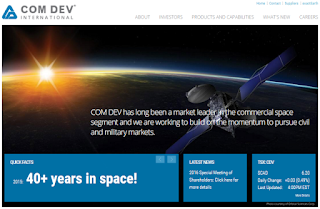By Brian Orlotti
On April 24th, as part of Waterloo, Ontario's contribution the upcoming International Space Apps Challenge a small Canadian NewSpace start-up plans to help unveil Canada’s first space startup accelerator.
On April 24th, as part of Waterloo, Ontario's contribution the upcoming International Space Apps Challenge a small Canadian NewSpace start-up plans to help unveil Canada’s first space startup accelerator.
The move is an important milestone in Canadian space history and highlights the continuing shift of space activities away from government/academia-focused models and towards those of the IT industry.
 |
| Bob Dylan singing "The Times They Are A Changin," in 1964. Screenshot c/o You-Tube. |
The revelation first came out in the March 22nd, 2016 Cantech letters post, "Waterloo’s SkyWatch to host regional NASA Space Apps Challenge." As outlined in the post:
SkyWatch is promising to open a “space startup-specific” accelerator sometime in 2016, providing a venue for open source, not-for-profit, and for-profit ventures, who will have access to technical resources, NASA’s open data and tools, community support and mentorship, and business resources to develop the next generation of space innovation solutions.
The tantalizing press release, lacking the specifics of who will fund the program and how it will be administered, seems almost to have been released by accident. As outlined in e-mail correspondence with SkyWatch Space Applications co-founder James Slifierz:
...While the press release mostly pertains to the Space Apps Challenge (which will be held in Waterloo on April 22nd - 24th), there is mention of the accelerator.
Co-founder Slifierz. Photo c/o Linked-In.
Other than the fact that it will be coming in 2016, and that it will be based in Waterloo, we won't be revealing any more facts until we get closer to the Space Apps Challenge...
We'll be putting out a press release the week of the Space Apps Challenge and I would be happy to talk about the details of the program at that point.
Skywatch Space Applications is a Waterloo, ON based company focused on creating apps that harness government open-sourced astronomical data.
As outlined in the May 19th, 2014 post, "CDN "SkyWatch" wins "Best Use of Data" at Int'l Space Apps Challenge," the origins of the company date back to April 2014, when it was a team competing in the 2014 NASA International Space Apps Challenge, an annual competition held in cities around the world in which teams create apps, robotics and other technologies that harness open-sourced data from NASA and other US government agencies.
As outlined in the May 19th, 2014 post, "CDN "SkyWatch" wins "Best Use of Data" at Int'l Space Apps Challenge," the origins of the company date back to April 2014, when it was a team competing in the 2014 NASA International Space Apps Challenge, an annual competition held in cities around the world in which teams create apps, robotics and other technologies that harness open-sourced data from NASA and other US government agencies.
Skywatch’s web app (also called Skywatch) provides real-time access to and visualization of astronomical/geospatial data culled from a wide variety of sources, including ground and space-based telescopes, drones, satellites and deep-space probes.
It's win and the resultant publicity attracted the attention of investors and enabled the group to form a company, which is now a part of the Communitech Hub, a Waterloo, ON based startup incubator with financial backing from Google, the C100 Group, the Ontario Network of Entrepreneurs (ONE) and the Government of Canada’s Networks of Centres of Excellence.
Of course, SkyWatch isn't the only bell weather in this area. Another sign of the ongoing fusion of the space and IT industries occurred just this past week.
As outlined in the March 22nd, 2016 Bloomberg article, "Amazon Secret Robot Event Boasts VR, Ax Making, Wood Splitting," Amazon.com organized a secret, invite-only conference in Palm Springs, California last week.
The event, focused around machine-learning, automation, robotics and space exploration (MARS), featured attendees from robotics and AI companies (i.e. Rethink Robotics, Toyota) as well as academia (MIT, University of California at Berkeley and ETH Zurich).
Amazon’s CEO Jeff Bezos is the founder and CEO of space company Blue Origin, which launched its New Sheppard reusable rocket last December and earlier this month opened its factory to the media.
The intensifying cross-pollination of the space and IT industries can also be seen in SpaceX CEO Elon Musk’s recent ventures with US-based tech incubator Y Combinator.
As outlined in the December 11th, 2015 BackChannel article, "How Elon Musk and Y Combinator Plan to Stop Computers From Taking Over," Musk and Y Combinator have jointly founded a new non-profit that will pursue artificial intelligence research and open source its data to the public. The space and IT industries, becoming increasingly intertwined, both stand to massively benefit.
After decades of wheel spinning, broken promises and doctrinal squabbling, the times they are a changin.’
It's win and the resultant publicity attracted the attention of investors and enabled the group to form a company, which is now a part of the Communitech Hub, a Waterloo, ON based startup incubator with financial backing from Google, the C100 Group, the Ontario Network of Entrepreneurs (ONE) and the Government of Canada’s Networks of Centres of Excellence.
Of course, SkyWatch isn't the only bell weather in this area. Another sign of the ongoing fusion of the space and IT industries occurred just this past week.
 |
| Jeff Bezos. Photo c/o Guardian. |
The event, focused around machine-learning, automation, robotics and space exploration (MARS), featured attendees from robotics and AI companies (i.e. Rethink Robotics, Toyota) as well as academia (MIT, University of California at Berkeley and ETH Zurich).
Amazon’s CEO Jeff Bezos is the founder and CEO of space company Blue Origin, which launched its New Sheppard reusable rocket last December and earlier this month opened its factory to the media.
 |
| Elon Musk. Photo c/o Brainprick. |
As outlined in the December 11th, 2015 BackChannel article, "How Elon Musk and Y Combinator Plan to Stop Computers From Taking Over," Musk and Y Combinator have jointly founded a new non-profit that will pursue artificial intelligence research and open source its data to the public. The space and IT industries, becoming increasingly intertwined, both stand to massively benefit.
 |
| Brian Orlotti. |
______________________________________________________________
Brian Orlotti is a network operations centre analyst at Shomi, a Canadian provider of on-demand internet streaming media and a regular contributor to the Commercial Space blog.



























